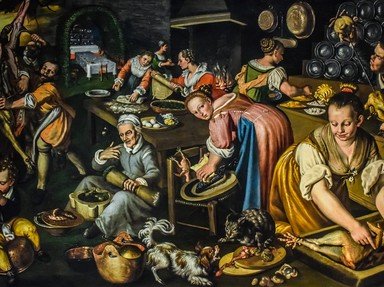Quiz Answer Key and Fun Facts
1. In this Titian painting, two mythological figures are present (and make up the title of the painting). One is Ariadne, abandoned on an island by Theseus. Leading a group of revelers in a cheetah-drawn chariot, who is the other mythological figure?
2. Most Renaissance painters, including da Vinci, painted the Last Supper scene from a front-facing perspective. Which Venetian painter instead depicted the scene from this altered perspective?
3. "Portrait of a Woman with a Man at a Casement" (c. 1440) depicts a domestic setting in which a man just barely pokes his head into a window to gaze at a woman (likely his betrothed). It was painted by the fascinating Italian Renaissance artist Filippo Lippi, who was also of what profession?
4. "Lamentation of Christ" (c. 1480) by Andrea Mantegna was ahead of its time in certain ways. It is now the consummate example in Italian Renaissance art of which perspective technique, which gives the human body depth in a painting?
5. Sofonisba Anguissola painted this 1555 masterpiece with the subjects believed to be her sisters. What game of the intelligentsia are her sisters playing in the painting?
6. "The Tribute Money" (c. 1425) by Masaccio depicts one of Jesus' biblical miracles from the Gospel of Matthew in which a coin appears in which creature's mouth?
7. Described by art historian John Pope-Hennessy as "by far the greatest fifteenth-century official portraitist," Giovanni Bellini shows off his talents by painting which political figure here?
8. This painting by Piero della Francesca was likely painted between 1468-1470 and features a prominent scene in the Bible. Interestingly, Jesus is not one of the figures in the foreground, but can be found instead in the background. What is the title of the painting?
9. Located (rather appropriately) in the Uffizi, this panel of "The Battle of San Romano" (c.1435-1460) by Paolo Uccello depicts a battle between Sienese and what other forces?
10. Pietro Perugino's pupil, Raphael, designed the tapestries that hung on its walls. Michelangelo's art graced its ceiling. And pictured here, "The Delivery of the Keys" (c. 1481-1482) by Pietro Perugino himself was commissioned to decorate it by Pope Sixtus IV. Which building is it?
Source: Author
trident
This quiz was reviewed by FunTrivia editor
ponycargirl before going online.
Any errors found in FunTrivia content are routinely corrected through our feedback system.
